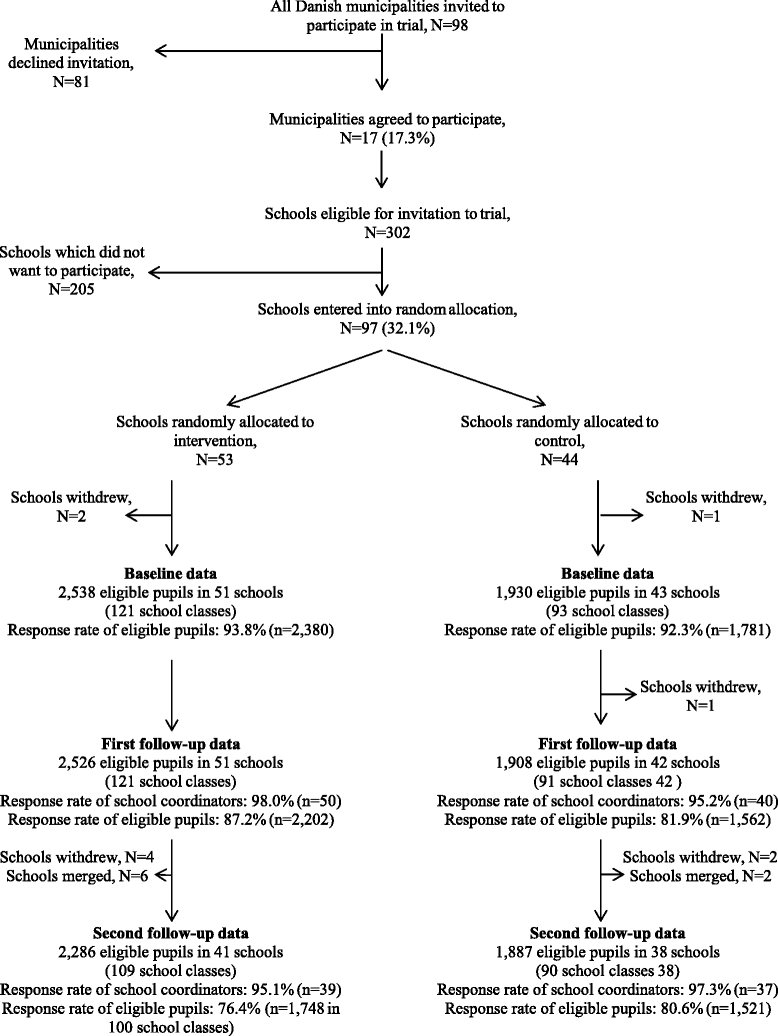High impact of implementation on school-based smoking prevention: the X:IT study-a cluster-randomized smoking prevention trial
- PMID: 27640187
- PMCID: PMC5027074
- DOI: 10.1186/s13012-016-0490-7
High impact of implementation on school-based smoking prevention: the X:IT study-a cluster-randomized smoking prevention trial
Abstract
Background: Implementation fidelity describes how well an intervention is implemented in the real-world setting. Assessing implementation fidelity is essential in the understanding of intervention results. In most studies, implementation fidelity is measured insufficiently, though, not taking into account the complexity of the concept nor the intervention. The objective of the present study was to develop an overall quantitative measure of implementation fidelity, to examine the degree of implementation fidelity and the association of implementation and effect of a randomized school-based smoking prevention trial-the X:IT study.
Methods: A cluster-randomized trial testing is a multi-component intervention to prevent smoking among adolescents in 94 Danish elementary schools (51 intervention, 43 control schools). Participants were grade 7 pupils (mean age 12.5 years). Data was collected by electronic questionnaires among pupils at baseline (n = 4161), the first follow-up (n = 3764), and the second follow-up (n = 3269) and among school coordinators at intervention schools at the first and second follow-up (50 and 39 coordinators).
Intervention: The intervention included three components: (1) smoke-free school grounds, (2) smoke-free curriculum, and (3) parental involvement, contracts, and dialogues. Implementation fidelity was assessed by four domains: adherence, dose, quality of delivery, and participant responsiveness. These were combined into an overall school-wise implementation index. The association of implementation and smoking was examined by logistic regression analyses.
Results: One fourth of the schools was characterized as high implementers of the program (all three components) at both first (12 schools, 24.0 %) and second follow-up (11 schools, 28.2 %). Implementation fidelity was strongly associated with smoking at the first and second follow-up, e.g., the odds for smoking at schools with high implementation both years were OR = 0.44 (95 % CI 0.32 to 0.68).
Conclusions: Using an overall measure based on several aspects of implementation fidelity, we showed a negative graded association between implementation and smoking. This study suggests that higher degrees of implementation will improve the effect of the X:IT intervention. Studying the association between implementation and effect is extremely important; only by doing so, we can distinguish the quality of the intervention from the success of the implementation.
Trial registration: Current Controlled Trials ISRCTN77415416.
Keywords: Adolescents; Fidelity; Implementation; Intervention effect; School intervention; Smoking prevention.
Figures


References
-
- Bellg AJ, Borrelli B, Resnick B, Hecht J, Minicucci DS, Ory M, Ogedegbe G, Orwig D, Ernst D, Czajkowski S. Enhancing treatment fidelity in health behavior change studies: best practices and recommendations from the NIH Behavior Change Consortium. Health Psychol. 2004;23:443. doi: 10.1037/0278-6133.23.5.443. - DOI - PubMed
Publication types
MeSH terms
Associated data
LinkOut - more resources
Full Text Sources
Other Literature Sources
Medical

